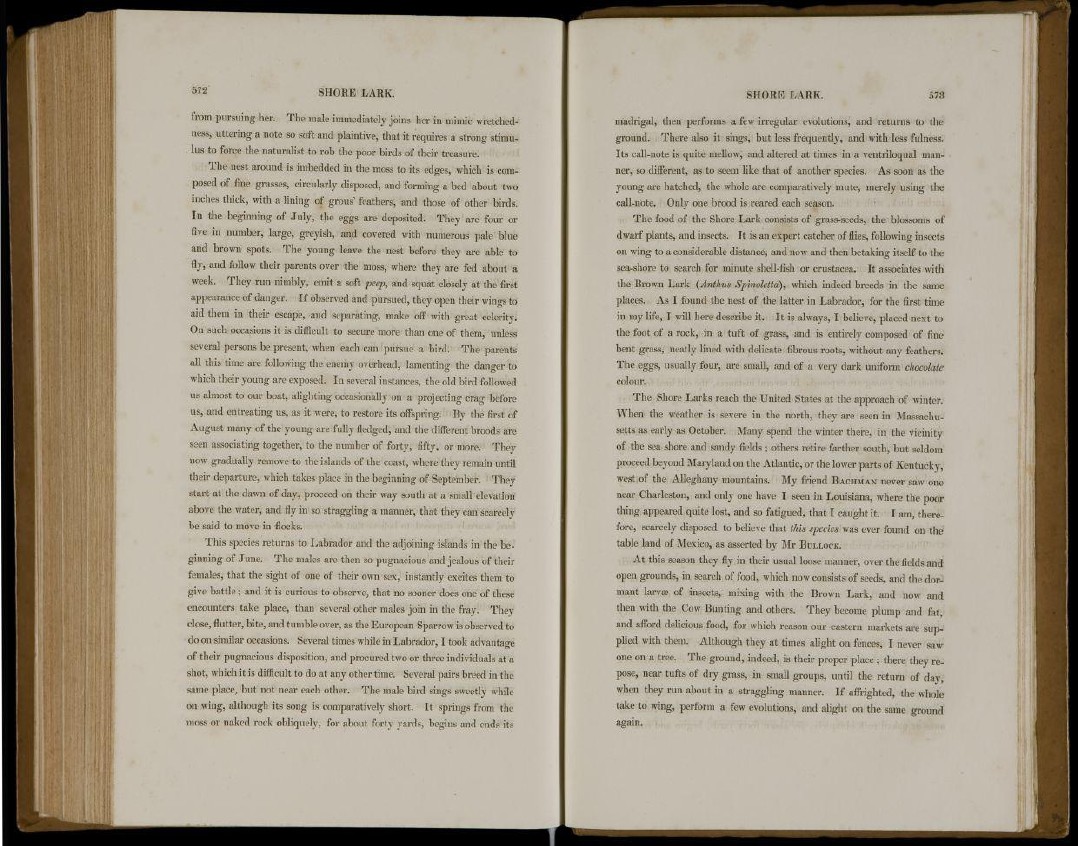
from pursuing her. The male immediately joins her in mimic wretchedness,
uttering a note so soft and plaintive, that it requires a strong stimulus
to force the naturalist to rob the poor birds of their treasure.
The nest around is imbedded in the moss to its edges, which is composed
of fine grasses, circularly disposed, and forming a bed about two
inches thick, with a lining of grous1 feathers, and those of other birds.
In the beginning of July, the eggs are deposited. They are four or
five in number, large, greyish, and covered with numerous pale blue
and brown spots. The young leave the nest before they are able to
fly, and follow their parents over the moss, where they are fed about a
week. They run nimbly, emit a soft peep, and squat closely at the first
appearance of danger. If observed and pursued, they open their wings to
aid them in their escape, and separating, make off with great celerity.
On such occasions it is difficult to secure more than one of them, unless
several persons be present, when each can pursue a bird. The parents
all this time are following the enemy overhead, lamenting the danger to
which their young are exposed. In several instances, the old bird followed
us almost to our boat, alighting occasionally on a projecting crag before
us, and entreating us, as it were, to restore its offspring. Ry the first of
August many of the young are fully fledged, and the different broods are
seen associating together, to the number of forty, fifty, or more. They
now gradually remove to the islands of the coast, where they remain until
their departure, which takes place in the beginning of September. They
start at the dawn of day, proceed on their way south at a small elevation
above the water, and fly in so straggling a manner, that they can scarcely
be said to move in flocks.
This species returns to Labrador and the adjoining islands in the beginning
of June. The males are then so pugnacious and jealous of their
females, that the sight of one of their own sex, instantly excites them to
give battle; and it is curious to observe, that no sooner does one of these
encounters take place, than several other males join in the fray. They
close, flutter, bite, and tumble over, as the European Sparrow is observed to
do on similar occasions. Several times while in Labrador, I took advantage
of their pugnacious disposition, and procured two or three individuals at a
shot, which it is difficult to do at any other time. Several pairs breed in the
same place, but not near each other. The male bird sings sweetly while
on wing, although its song is comparatively short. It springs from the
moss or naked rock obliquely, for about forty yards, begins and ends its
madrigal, then performs a few irregular evolutions, and returns to the
ground. There also it sings, but less frequently, and with less fulness.
Its call-note is quite mellow, and altered at times in a ventriloqual manner,
so different, as to seem like that of another species. As soon as the
young are hatched, the whole are comparatively mute, merely using the
call-note. Only one brood is reared each season.
The food of the Shore Lark consists of grass-seeds, the blossoms of
dwarf plants, and insects. It is an expert catcher of flies, following insects
on wing to a considerable distance, and now and then betaking itself to the
sea-shore to search for minute shell-fish or Crustacea. It associates with
the Brown Lark (Anthus Spinoletta), which indeed breeds in the same
places. As I found the nest of the latter in Labrador, for the first time
in my life, I will here describe it. It is always, I believe, placed next to
the foot of a rock, in a tuft of grass, and is entirely composed of fine
bent grass, neatly lined with delicate fibrous roots, without any feathers.
The eggs, usually four, are small, and of a very dark uniform chocolate
colour.
The Shore Larks reach the United States at the approach of winter.
When the weather is severe in the north, they are seen in Massachusetts
as early as October. Many spend the winter there, in the vicinity
of the sea shore and sandy fields ; others retire farther south, but seldom
proceed beyond Maryland on the Atlantic, or the lower parts of Kentucky,
west of the Alleghany mountains. My friend BACHMAN never saw one
near Charleston, and only one have I seen in Louisiana, where the poor
thing appeared quite lost, and so fatigued, that I caught it. I am, therefore,
scarcely disposed to believe that this species was ever found on the
table land of Mexico, as asserted by Mr BULLOCK.
At this season they fly in their usual loose manner, over the fields and
open grounds, in search of food, which now consists of seeds, and the dormant
larva; of insects, mixing with the Brown Lark, and now and
then with the Cow Bunting and others. They become plump and fat,
and afford delicious food, for which reason our eastern markets are supplied
with them. Although they at times alight on fences, I never saw
one on a tree. The ground, indeed, is their proper place ; there they repose,
near tufts of dry grass, in small groups, until the return of day,
when they run about in a straggling manner. If affrighted, the whole
take to wing, perform a few evolutions, and alight on the same ground
again.